THE BEST PLACES FOR FAMILIES TO STAY IN JAPAN
Planning a family holiday to JAPAN and wondering where to stay with your children? The following list of our favourite places to stay with kids, reviewed in the order you’d encounter them on our Big Trip Japan itinerary, includes skyscraper hotels, mountaintop temples, traditional ryokans in the heart of Kyoto and family homestays in forgotten valleys.
Japanese-style rooms can often accommodate more people so are generally better value for bigger families than booking family suites or two Western-style rooms. Note that the vast majority of places in Japan charge per person rather than per room.
With the exception of Ku-Nel-Asob, you can reserve all of our recommended places to stay in Japan through Booking.com; clicking on the hotels’ name below will take you directly to their booking page, where you can fill in your dates and secure your stay. To find out more about why we’ve partnered with Booking.com, see here.
TAKANAWA HANAKOHRO, TOKYO
As an introduction to Japanese accommodation, and to Tokyo and Japan in general, TAKANAWA HANAKOHRO takes some beating. Everything you’ve probably been looking forward to experiencing (tatami-mat floors, sliding shoji paper screens, tranquil Japanese gardens) is here, but in a setting that’s a lot more relaxed than you might have been expecting. This ryokan-within-a-hotel has just 16 rooms, sparsely but immaculately decorated in traditional Japanese style, with ikebana (flower arrangements) and hanging scrolls. Adults sleep in comfy low beds, kids (up to 3 of them) sleep on futons on the lounge floor [¥15,000 per futon per night; under-6s free], which are made up each night; by day, this area has plush swivel chairs set around a low table. There’s also a smart en-suite bathroom and a kind of side galley with tea- and coffee-making facilities. Staying here is a significant splurge, but you’re paying for the full experience, from the exceptional staff, who welcome you with Japanese sweets and hot hand towels, to the novelty of dressing up for breakfast in a yukata gown, zori sandals and unusual-looking socks (the big toe is separated from the others!). The hotel is surrounded by beautiful gardens, with cherry trees, koi-carp ponds, miniature temples, and a traditional tea house where you can take part in a Japanese tea ceremony, trying your hand at whisking up the green powder into a bitter foam. Kimono-clad staff can also come to your room to show you how to make origami cranes. A very interesting multi-course breakfast is included in the price – your kids will need to be happy tackling miso soup and raw fish first thing in the morning – and for dinner you can either try the restaurants and cafés in the hotel itself or head out to one of the excellent ramen-noodle places that are just a few minutes’ walk away. Rates also include complimentary tea (daily drinks and Japanese sweets), cocktails and a “nightcap” in the Club Lounge. Takanawa Hanakohro enjoys a particularly good location in central Shinagawa; the hotel is around 5 minutes’ walk from Shinagawa Station (for the JR Yamanote Line to Shibuya, Harajuku and Shinjuku) and about the same distance, in the opposite direction, from Takanawadai Station (for the JR Asakusa Line to Asakusa).
To reserve your stay at Takanawa Hanakohro, click here

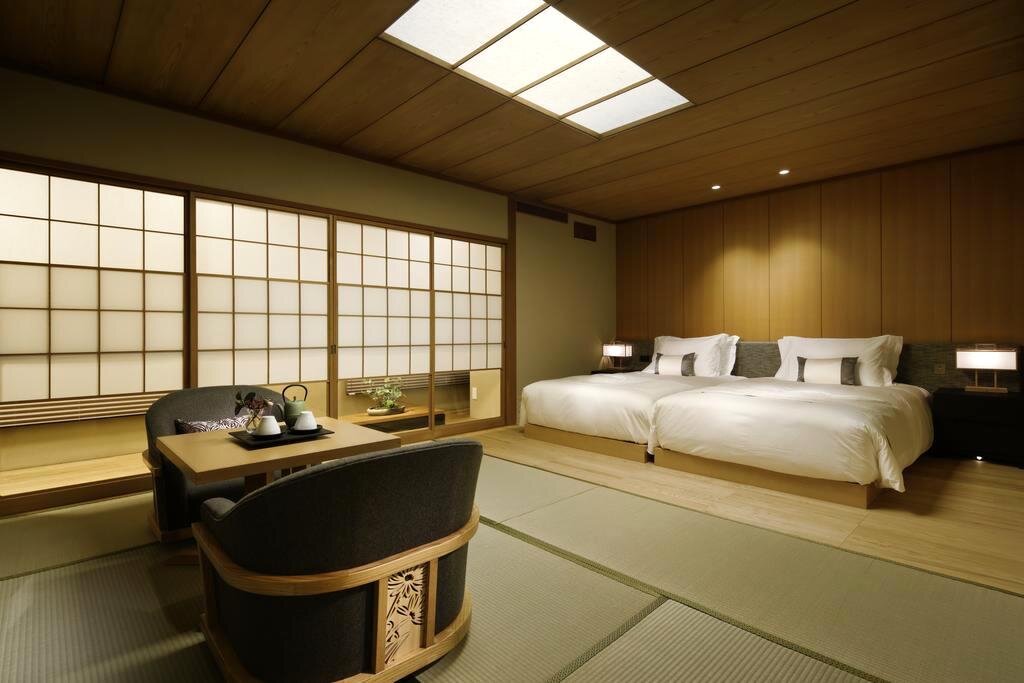
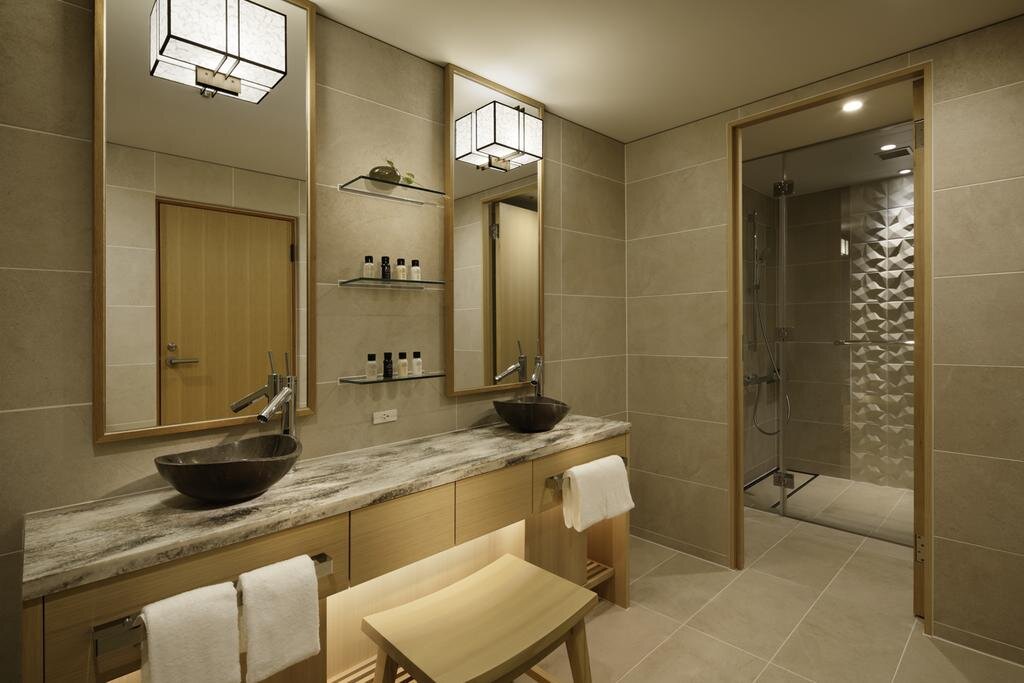


For more images of Takanawa Hanakohro, see Booking.com
PRINCE PARK TOWER TOKYO
Surrounded by the greenery of Shiba-Koen, the luxurious PRINCE PARK TOWER TOKYO is something of a sanctuary in the busy Minato district. The group’s flagship hotel, the Park Tower Tokyo has some of the most spacious rooms in the city and, as its name suggests, amazing views of the iconic Tokyo Tower, specifically designed to be ever so slightly taller than the Eiffel Tower. All the rooms are on the large size. The bigger Deluxe Twin Rooms can sleep up to 3 people, with one on a sofa bed. With more children, you’ll need to get connecting rooms. Take your pick from Standard Twin Rooms and Deluxe Twin Rooms through to newly renovated Panoramic Rooms and the smart, darkly styled Premier King Rooms, which have a large king bed and a swish bathroom with a deep square bath, plus a balcony at birds’-eye level. Premier Rooms also have access to the 32nd-floor Premium Club Lounge, which looks directly out onto the Tokyo Tower and the city’s twinkling skyscrapers, although one of the best things for kids about being on the upper floors is getting to ride the hotel’s nippy sci-fi lifts! The Park Tower Tokyo also has its own bowling salon in the basement [until 6pm | ¥1000, including bowling shoes; free if staying in Premium]. There are half a dozen excellent restaurants, including places that specialise in yakitori, sushi and tempura, and a restaurant that serves kaiseki-ryori – high-quality, traditional Japanese cuisine. Hotel rates include Western- or Japanese-style breakfasts and, for Premier Rooms, complimentary tea (daily drinks and Japanese sweets), cocktails and a “nightcap” in the Club Lounge. Three subway stations are within an easy 10-minute walk: Shiba-koen, for Tokyo Station; Akabanebashi, for Odaiba (Miraiken and teamLab*Borderless) and Daimon, for Asakusa.
To reserve your stay at Prince Park Tower Tokyo, click here
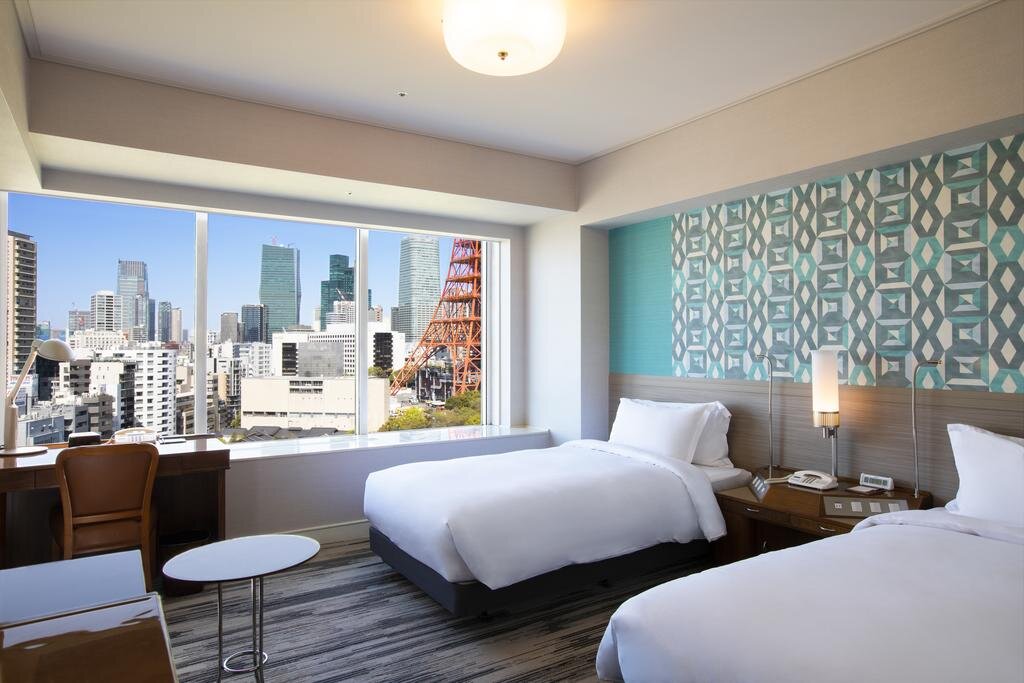

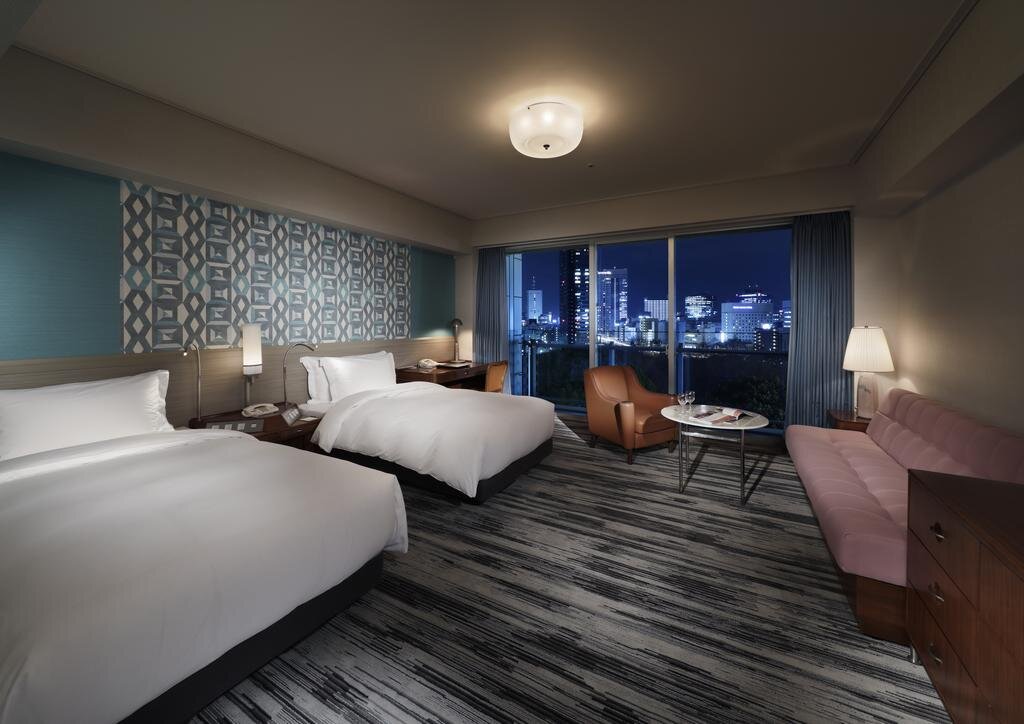


For more images of Prince Park Tower Tokyo, see Booking.com
PETIT GRANDE MIYABI, TOKYO
Tokyo can be an expensive place to stay for families, even by Japan’s standards, so the PETIT GRANDE MIYABI is a real find. Set in a quiet part of the Ryogoku district in East Tokyo, this new aparthotel occupies a modern building but has touches of Old Japan: stone lanterns, juniper trees and a traditional-style entranceway. There are 25 rooms in total, light and fresh in a Scandinavian kind of way and each with a kitchenette, seating area, flat-screen TV and en-suite bathroom. They all also come stocked full of facilities such as a fridge, hob, microwave and washing machine/drier – this would be a good place to settle down for an extended stay in the capital. Families of 3 will be content in a Double Room with Extra Single Bed. Larger families can opt for a Twin Room, which has two large double beds (sleeping up to 4), or a Superior Family Room, which is more than half as big again, has a dining area with a dining table, and can sleep up to 6 people in two doubles and two singles; it’s all open plan bar the bathroom, and there are a lot of furniture and facilities in here, but it’s a decent space. The “single beds” in both these types of rooms are essentially foldable futons that double up as armchairs during the day. An excellent Japanese-style breakfast is included in the rates. Ryogoku is across the Sumida River from Asakusabashi (for the JR Asakusa Line to Asakusa) and is the historical home of sumo wrestling in Japan. There are several sumo stables in the vicinity, so you might meet a few wrestlers on their way to and from training, and several restaurants in the neighbourhood serve chanko nabe, a protein-heavy stew that forms a key part of a sumo wrestler’s diet. The Ryogoku Kokugikan, a sumo stadium that will host the boxing during the “Tokyo 2020” Olympics, is a 10-minute walk away, next to Ryogoku Station (for the JR Chuo-Sobu or Toei Oedo subway lines).
To reserve your stay at Petit Grande Miyabi, click here

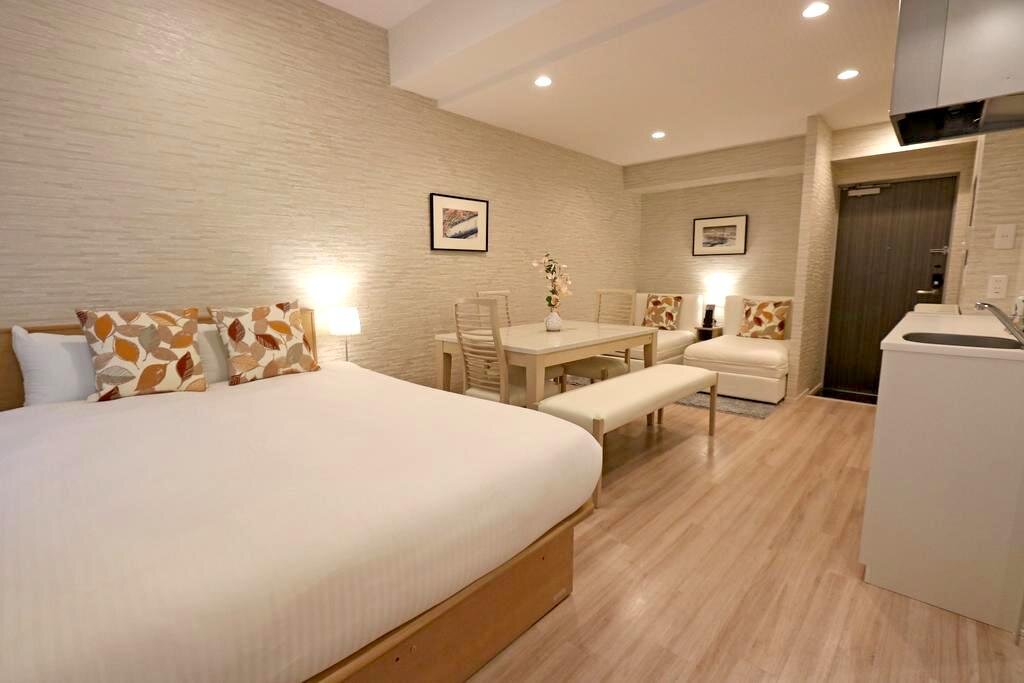



For more images of Petit Grande Miyabi, see Booking.com
PRINCE HOTEL LAKE ASHINOKO, HAKONE
Set on the shorefront of Lake Ashinoko, a few hundred metres north of Moto-hakone, the PRINCE HOTEL LAKE ASHINOKO is the perfect place to rest up after a busy day’s sightseeing on the circuit round Hakone. The pirate galleon ships that traverse the lake dock at the pier in Moto-hakone, and the hotel is close enough to town to take advantage of the range of restaurants there at dinner time but far enough to feel secluded. All the rooms here are on the large side, and are much more spacious than the majority of hotels in Hakone. The circular main building has Triple Rooms with garden views that can sleep up to 5, in two double beds and a sofa bed; in the annex, closer to the lake, options include light-filled Superior Quadruple Rooms (sleeping 4 in two singles and two sofa beds) and Family Rooms that sleep up to 6 in two doubles and a couple of extra beds [children under 6 stay free if they share the bed]. All rooms have flat-screen satellite TV and a fridge. Scout around the drawers and you’ll find outfits to wear down to the hotel’s fantastic open-air onsen, along with a reassuring “How To” guide – handy if this is your first time hitting the hot springs. Work your way through the indoor hot and cold baths before heading outside for a dip just yards from the lakeshore. Breakfast is very pricey if you haven’t already booked [¥3000, ¥2200 for under-12s, ¥1100 for under-6s]; unusual items include white omelette (from chickens fed on rice) and eggs boiled in hot springs. Free shuttle buses run between the hotel and Moto-hakone (for the cruise on Lake Ashinoko) and Odawara Station (for Shinkansen trains to Tokyo and Osaka).
To reserve your stay at Prince Hotel Lake Ashinoko, click here



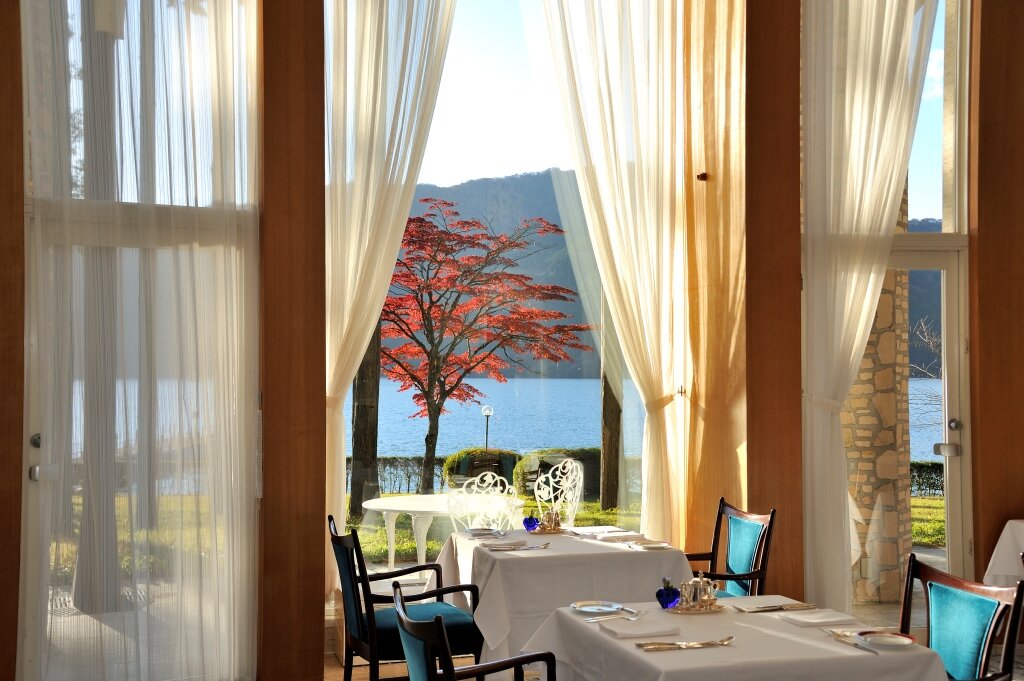

For more images of Prince Hotel Lake Ashinoko, see Booking.com
KAMON HOTEL NAMBA, OSAKA
The lively Namba area is the best place to base yourself for an overnight stop in Osaka, and the friendly KAMON HOTEL NAMBA is right in the thick of the action – it’s just a short stroll to Kuromon Market, whilst the neon signs and sizzling street food of canalside Dotonbori are less than 10 minutes’ walk in the other direction. Despite such a central location, the hotel’s setting in a narrow side alley means you can enjoy a quiet night, too. It's so tucked away, in fact, that it’s quite easy to miss – the entrance is marked by an ancient-looking rickshaw. The interior is smart, with a trendy little lobby, a traditional-style raised wooden seating area, a modern café-bar, and a rooftop terrace that doubles up as a kind of outdoor lounge. There are 38 rooms, including half a dozen Quadruple Rooms (sleeping up to 4) and a couple more Family Rooms (sleeping up to 6), similar in their sleek design, though the latter are more spacious (they’re about half the size again) and have a great separate sitting area. Kids will be happy in either, as they both feature cosy enclosed bunk beds, which are set into the wall like cubicles [children under 7 stay for free]. Facilities include LCD TV, kettle and fridge-freezer; there are tablets in the rooms, too, and you can rent Nintendo games consoles for free. A hearty buffet breakfast [¥1200, free for under-6s] is served in the café each morning. Kamon is also conveniently located for the major transport hub of Namba Station, less than 10 minutes’ walk away – Namba is on the Midosuji Line from Shin-Osaka Station, where Shinkansen from Tokyo and Hakone (Odawara Station) pull in, and is the departure point for Nankai Koya Line trains to Koya-san.
To reserve your stay at Kamon Hotel Namba, click here





For more images of Kamon Hotel Namba, see Booking.com
EKO-IN, KOYA-SAN
A night in the atmospheric EKO-IN temple on Koya-san will probably be one of the cultural highlights of your trip. More than 50 monasteries dotted round the holy mountain provide shukubo, as temple lodgings are known, but 1000-year-old Eko-in offers the full experience. Apart from the novelty of sleeping in an actual temple, spending the night here will give you a brilliant insight into the life of a working monk, as well as the opportunity to get involved in their daily routine. The Japanese-style rooms, most of which overlook the temple’s tranquil garden, are comfortable and cosy, with painted screens and hanging scrolls in the way of decoration and futons set out at night on tatami-mat floors. It’s worth getting here early [check-in is from 2pm], so you can make the most of your stay and take part in any of the activities that are on offer. At Eko-in, this includes a monk-led Akijan meditation session at 4.30pm (probably best left for the adults, although children are welcome) and trying your hand at Buddhist sutra writing in your room. You can also explore the gardens and take a dip in the onsen – there are set bathing times, and don’t be surprised if you end up sharing your bath with a monk or two. You’ll need to make an early start in the morning if you want to catch the prayer service [6.30am], worth it for the monk’s hypnotic chanting, and you should definitely get everyone up for the dramatic goma taki fire ceremony that follows, in which a hundred or so pieces of wood are symbolically set alight. All activities are free to guests. The food at Eko-in is also likely to be eye-opening, with Buddhist vegetarian meals (shojin-ryori) served at both dinner and breakfast, in the form of soups, a variety of tofu dishes and all sorts of vegetables and vegetable derivatives – who knew you could make a jelly out of potato starch? Eko-in is conveniently located for the Okunoin Cemetery, and is the departure point for spooky night tours [depart daily at 7.15pm | ¥2500, including return bus transfer, ¥2300 if booked online in advance] of the mist-draped tombs.
To reserve your stay at Eko-in, click here





For more images of Eko-in, see Booking.com
HOTEL MONTEREY HIMEJI
The smart, new HOTEL MONTEREY HIMEJI is perfectly located for an overnight stop on your way between Koya-san and Shikoku. Just around the corner from Himeji Station, the hotel is 15 minutes’ walk straight down the main street of Otemae-dori to the landmark Himeji-jo castle and the adjoining Himeji Koko-en gardens. The interior is surprisingly elegant for such a modern hotel, from the impressive lobby, with its huge, ceiling-height picture windows, through to the swish revitalising little onsen (free to hotel guests) on the fourth floor; the touches of Art Deco styling throughout are a nod to the fact that Himeji is twinned with Charleroi in Belgium. Standard Triple rooms have comfy Western beds; they’re listed as sleeping 3 but can easily cater for more if your children are young. Bigger Family Rooms are Japanese style, with tatami-mat floors and a low centre table and legless chairs that are cleared away in the evening to make space for billowing futons. All rooms are air conditioned and have flat-screen TVs and en-suite bathrooms. They also all come with free rental smartphones, which you can carry round town as a portable local travel guide – handy for looking up eating recommendations if you’re not going to be dining in the hotel’s own Italian restaurant. Breakfast, a good buffet spread, is served in a rather grand ballroom.
To reserve your stay at Hotel Monterey Himeji, click here





For more images of Hotel Monterey Himeji, see Booking.com
KU-NEL-ASOB, IYA VALLEY
An eco-friendly minshuku on the edge of Shikoku’s Iya Valley, KU-NEL-ASOB is run by husband-and-wife team Nori and Kaori, whose easy charm will quickly make you feel very at home in their traditional 100-year-old Japanese house. You’ll be in one of five private rooms that are set off the main kitchen-diner; they’re simple but comfortable tatami-mat affairs, with cosy blanket-topped futons for beds. A big part of staying here is gathering around the dining table each night with other guests for a multi-course vegetarian feast cooked up by Karori, who clearly takes great pride in producing a delicious array of local dishes. Breakfast is equally tasty. There’s no shower at Ku-Nel-Asob, but in the late afternoon Nori will ferry guests to a nearby riverside onsen (transfer and entry included in the room rate). Both Nori, who speaks excellent English, and Kaori are super-friendly hosts, and Nori in particular has lots of tips and advice for exploring the local area, whether you want to take a drive through the Iyakei Gorge, hike through mountain villages in the Oku-Iya or cruise along the nearby Oboke Gorge. Given Ku-Nel-Asob’s lovely location, at the top of a forested hill that overlooks the Yoshino River, you may just want to sit tight and enjoy the peace and tranquillity – and the gorgeous views from the front porch. You really need your own wheels to properly explore the Iya Valley, but if you’re arriving by train, then Nori can provide a free pick-up service [between 3pm and 6pm] from JR Oboke Station, 3km to the north, and he can also drop you off there at the end of your stay.




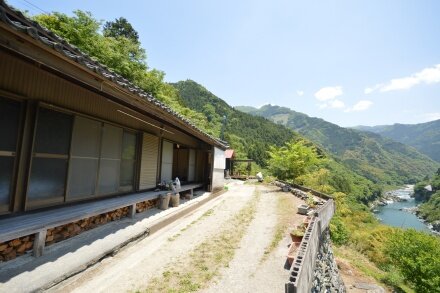
GRAND PRINCE HOTEL HIROSHIMA
The GRAND PRINCE HOTEL HIROSHIMA enjoys a superb setting on the Seto Inland Sea, around 7km south of Hiroshima Station – staying outside of the city centre is a good option if you want a break from all the moving memorials. The open lobby with its impressive fountain sets the tone for this airy, light-filled hotel, which fronts a strip of beach and has a small swimming pool in summer. Compact Standard Triple Rooms sleep 3 people in a cosy set-up of two singles and a sofa bed, but it’s worth paying a little bit extra to upgrade to the angular Standard Family Rooms, which are twice the size and can sleep 3 or 4 people in two single beds and either one or two sofa beds. All the rooms have large picture windows, framing a seascape of forest-covered islets scattered across Hiroshima Bay, as well as flat-screen TVs. Room rates do not apply for children under 6. There are four restaurants, serving Japanese, Chinese and American food, with one specialising solely in okonomiyaki pancakes, plus a “Top of Hiroshima” Sky Lounge that has great seaward views [kids allowed until 9.30pm]. A free shuttle bus runs between Hiroshima Station and the hotel (30 minutes), departing in each direction roughly every hour and a quarter. You can also catch a ferry from the pier in front of the hotel direct to Miyajima [25 minutes | ¥1900, children ¥950, return ¥3400, children ¥1700], which can cut up to 45 minutes off the journey by bus, train and ferry via Miyajima-guchi.
To reserve your stay at Grand Prince Hotel Hiroshima, click here





For more images of Grand Prince Hotel Hiroshima, see Booking.com
TOSHIHARU, KYOTO
If there’s one place you must stay if you get the chance, it’s at a ryokan, an atmospheric inn that offers the ultimate combination of traditional Japanese living and old-school Japanese hospitality. Located in the heart of Kyoto, but tucked down a quite side street, TOSHIHARU was built in 1909 and, as one of Japan’s tangible cultural properties, it oozes character. Set around a garden courtyard, whose stone lanterns are lit up in the evening, are just six guestrooms – swap your shoes for a pair of slippers at the entrance to the ryokan and then head to yours. Pull back the sliding paper screen door and you’ll be greeted by a large tatami-mat floor; kids will love the novelty of padding round on this barefoot (you need to take your slippers off before walking on the tatami) whilst dressed in a yukata, a kind of light, comfortable kimono. Rooms are minimally furnished, with just a low table in the centre, surrounded by cushioned legless chairs, a wardrobe that blends into the wall, and an ornamental alcove (known as a toko-no-ma), which is decorated with a hanging scroll (kake-jiku) and a fresh flower arrangement (ikebana) crafted by the owner. At some point in the late afternoon or early evening, whilst you’re out, a kimono-clad member of staff will slip into your room, whisk away the table and chairs and lay out your futons (a stack of thick mattresses and padded blankets) so the whole family can pile together on the floor for the night. Book your time-slot in the traditional Japanese cedar bath – you’ll also need to change out of your slippers into a special communal pair whenever you use the bathroom – and you’ll have a piping hot bath waiting for you. Unlike many pricier ryokans, Toshiharu doesn’t serve dinner, but there are dozens of restaurants within a 5-minute walk; you’re also about 15 minutes from Nishiki Market and around 20 to 25 minutes from Gion and Ponto-cho. A traditional breakfast (rice, miso soup, grilled fish, tofu, Japanese rolled omelette) costs ¥2300.
To reserve your stay at Toshiharu, click here

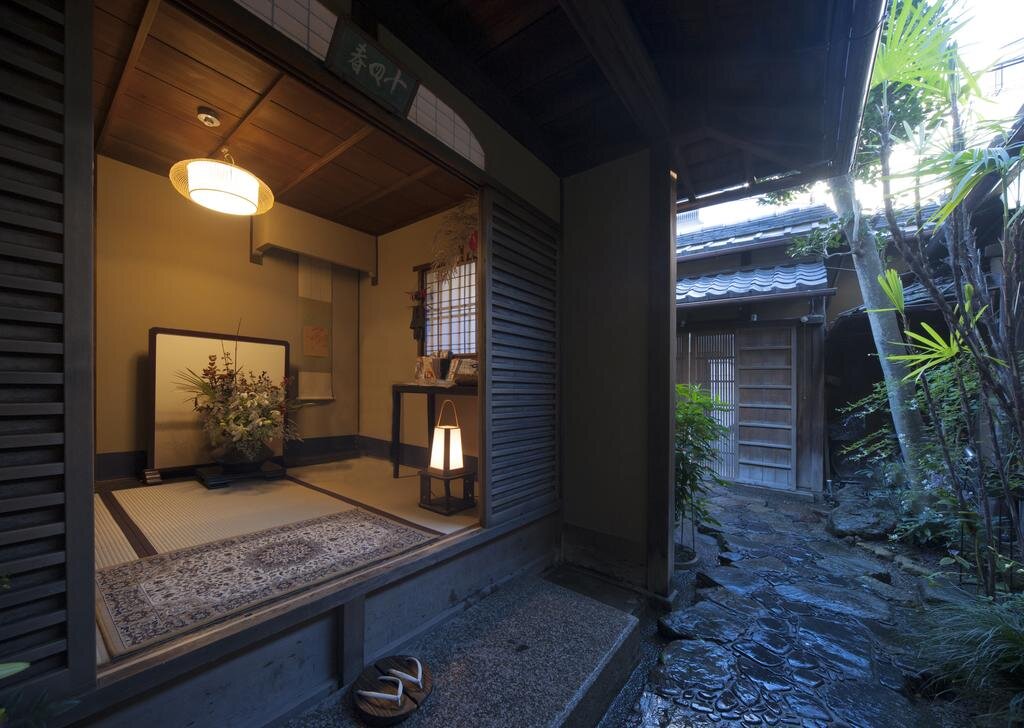



For more images of Toshiharu, see Booking.com
IORI MACHIYA, KYOTO
As one of the best-preserved big cities in Japan, Kyoto is a great place to experience life in a machiya, a style of traditional wooden townhouse that was once prevalent across the country. IORI MACHIYA offers authentic stays in over a dozen beautifully restored machiya that date back to the late Edo period, so you can live like feudal lords while exploring Kyoto. Their range of houses sleep between 2 and 9 people, though most have a capacity of 6. In each of them, expect stone entranceways, tatami-mat floors, sliding doors, miniature gardens and Japanese-style baths – plus modern conveniences like underfloor heating, air-con and wi-fi. Some of the properties have been updated inside more than others; the best, and the best value, are Iori’s original-style machiya: Ebisuya-cho, Hirano-cho and Sujiya-cho. The latter, which is probably the pick of their portfolio, is a distinguished merchant’s mansion set across two floors – a luxurious amount of space for Japan. Downstairs, there’s a seating area in what used to be the shop, a well-equipped kitchen-diner, and a tatami-mat room for Japanese-style dining; wooden corridors around your own ornamental garden lead to a stone bath and toilet. Upstairs are two bedrooms with chunky, comfy Western-style beds, a double tatami-mat room for (goose-down) futons, an additional shower room and toilet, and a little balcony-corridor overlooking the garden. All told, there’s enough sleeping space here for up to 9 people. Nearby Ebisuya-cho (sleeps up to 6) has its own tearoom, whilst Hirano-cho (also sleeps up to 6), located opposite a temple, has a cute enclosed courtyard entrance and a cedar bathtub from where you can enjoy views of its garden. Sujiya-cho and Ebisuya-cho are 10 minutes’ walk from Nishiki Market and Kawaramachi Station (for the Hankyu-Kyoto Line to Arashiyama via Katsura Station); Hirano-cho is further south, a 15-minute walk from Kyoto Station.
To reserve your stay at Iori Machiya, click here






For more images of Iori Machiya, see Booking.com
GUESTHOUSE RAKU, KYOTO
Don’t be deceived by the boxy-looking exterior of GUESTHOUSE RAKU. Push through the little half-curtain at the entranceway and you’ll find five very spacious Family Rooms, each one tastefully furnished and taking over an entire floor. The majority of them are set up with a Japanese-style lounge with cushions on the floor for seats, a fully equipped kitchenette with brunch bar, and two separate bedrooms, each containing a couple of queen-sized beds (sleeping up to 5); a smaller room sleeps up to 3 in two doubles. The owner is friendly and helpful with any pre-trip queries, although once you arrive you’ll need to check yourself in, which is all simple enough but means that Raku can lack the social interaction you might normally expect from a “guesthouse”. On the flip side, there’s plenty of that just outside the front door, as the surrounding neighbourhood is a very residential one, with locals going about their daily business and bakeries, cafés, restaurants and a supermarket all within walking distance. Despite this, Guesthouse Raku is just a 5-minute walk to Marutamachi Station, for the Karasuma Line to Shijō Station (and Nishiki Market), and only a minute or two more to Kyoto Gyoen, the large gardens that surround the city’s Imperial Palace.
To reserve your stay at Guesthouse Raku, click here


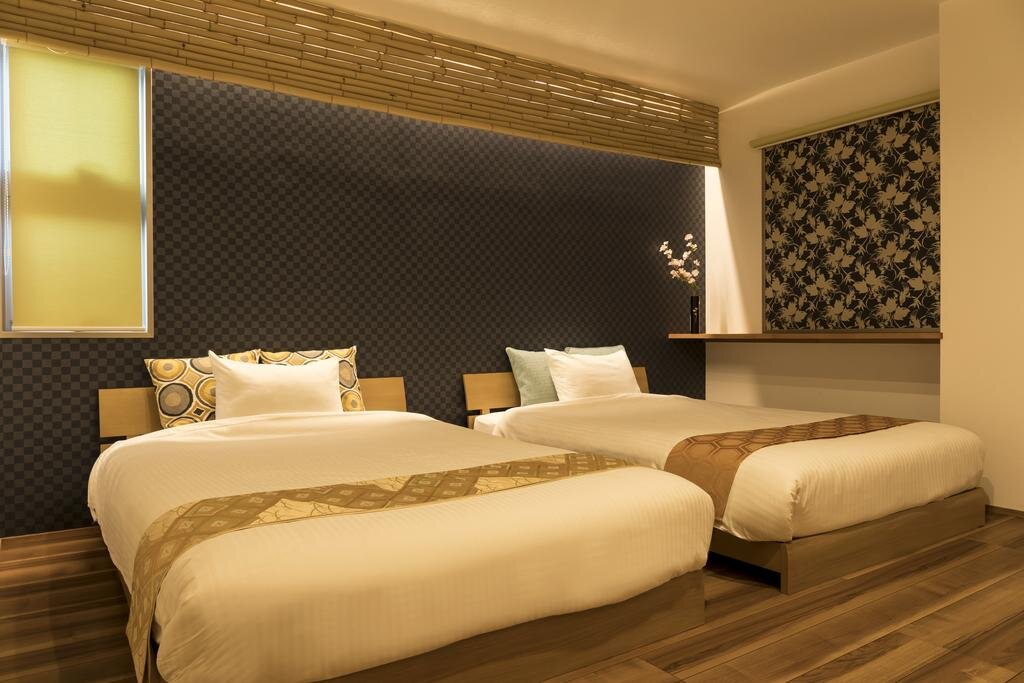

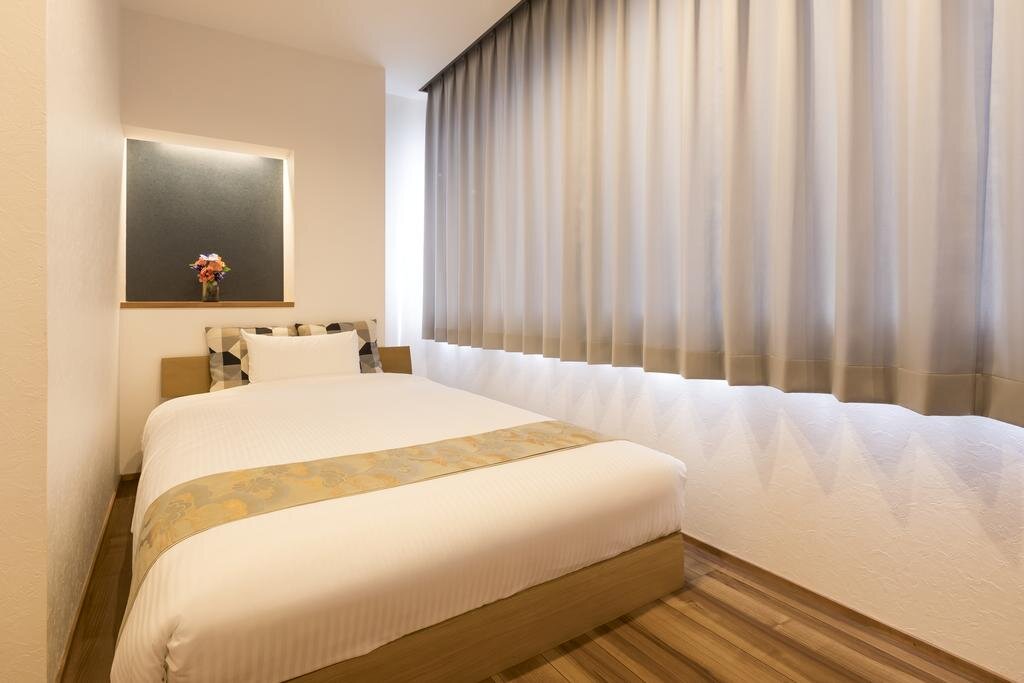
For more images of Guesthouse Raku, see Booking.com



